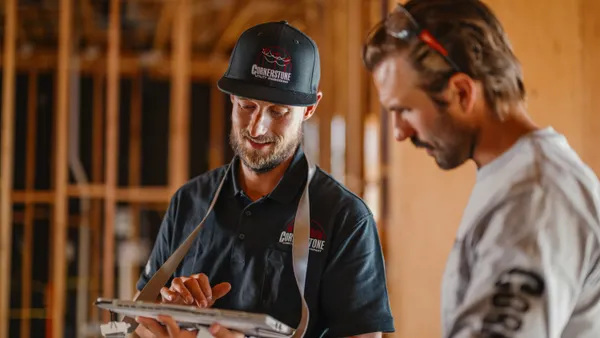As the construction industry continues to innovate and explore how different materials can help build buildings and infrastructure in a more sustainable and efficient manner, Construction Dive periodically will round up the latest news and what strides researchers are making in the space.
Cracks make this 3D-printed cement stronger
A team at Purdue University’s Lyles School of Civil Engineering has created a 3D-printed cement paste that gets stronger as it cracks, according to a statement from the university. The cement paste, inspired by arthropod shells, could help create more disaster-proof, resilient structures, according to the researchers.
The team used layering architectures, such as ones they called “honeycomb,” “compliant” and “Bouligand” designs, to create resilient cement structures once the material is hardened. Through various experiments, researchers aimed to understand how weak interfaces could make a material more crack-resistant, such as the Bouligand architecture showing that the cement-based elements behaved like a spring despite being made of brittle material. Micro-CT scans also allowed the team to examine how weak characteristics like pores between the printed layers actually create strength.
Concrete reinforced with natural fibers
Whereas textile-reinforced concrete traditionally has been reinforced with such materials as carbon- or glass-fiber fabrics in lieu of steel, researchers at the Germany-based Fraunhofer Institute for Wood Research have replaced the fabrics with eco-friendly natural fibers such as flax, which can be spun or woven. Adding strands of polymer fiber to the flax creates a hybrid fabric that can be specified to a given component’s requirements.
The variable stiffness of the flax-based textile, which is embedded in layers on a component, can be arranged into a desired shape. Specially developed liquid concrete comprising fine aggregate, water, concrete additives and admixtures is poured on the reinforcing flax textile to create components that can bear weight at only a few centimeters thick. Potential applications include bridges, façades and ceilings, as well as curved contours like domes and rounded wall elements.
‘Memory steel’ can reinforce new and existing concrete structures
Developed by Swiss firms Empa and re-fer AG, “memory steel” needs to be heated only once for prestressing to occur automatically. The material, a result of 15 years of research, can reportedly be used to reinforce new and existing concrete structures. The shape memory alloys are based on iron that contracts during heating, thereby permanently prestressing the concrete structure and avoiding hydraulic prestressing, which is how most steel reinforcements are prestressed.
Several pilot projects to reinforce various reinforced concrete slabs already have been successful. Empa says the material will allow crews to more easily reinforce load-bearing structures in old buildings when new windows, doors or lift shafts are installed. It also may have future capacity in manufacturing precast concrete parts with a previously unknown geometry.
Voestalpine Böhler Edelstahl GmbH & Co KG in Austria is manufacturing the ready-to-install memory steel profiles.
Material repairs itself with carbon dioxide from the air
MIT chemical engineers have created a polymer that will grow, strengthen and repair itself by continuously converting the greenhouse gas into a carbon-based material that reinforces itself, according to MIT News. Currently in a synthetic gel-like form, the material performs a chemical process similar to how plants pull CO2 from the air into their growing tissues. Initial experiments used chloroplasts from spinach leaves, which catalyzed the reaction of CO2 to glucose. Those chloroplasts in the polymer eventually will be replaced by nonbiological catalysts.
Although it isn’t yet strong enough to be used as a building material, it could work to fill cracks or be a coating, the researchers said. Exposure to sunlight and some indoor lighting could prompt the material to self-heal if it is scratched or cracked. In addition to pulling CO2 out of the air, the material also does not require fossil fuels for its creation, making it a sustainable product.












